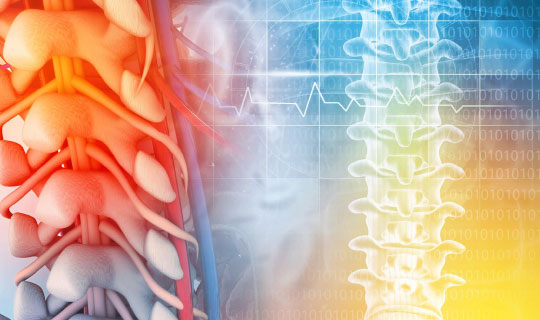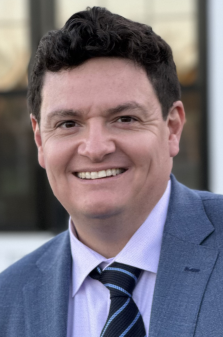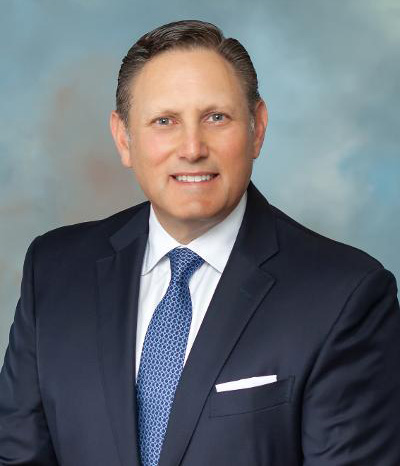
How a new robotic-assisted surgery helps reduce pain, speed healing and improve outcomes.
When you take a road trip, you trust your car’s global positioning system (GPS) to help you find the best route to your destination. Now, when specialists at Robert Wood Johnson University Hospital (RWJUH) Hamilton perform complex spine procedures, they use a leading-edge navigation system to create the best surgical outcomes possible.
While Globus Medical’s ExcelsiusGPS technology isn’t a GPS in the classic sense, it is one of the first surgical systems to combine a robotic arm with full computer-assisted navigation capabilities. As a result, surgeons can perform robotic-assisted spine surgery with enhanced precision.
Here’s how it works. Prior to the start of a minimally invasive spine procedure, surgeons upload a patient’s X-ray and CT scans into the ExcelsiusGPS robot.

“The surgeon, with assistance from the software, then selects the best trajectory and position for the procedure based on those images and the patient’s anatomy,” says Jose Canseco, MD, PhD, a fellowship-trained orthopedic spine surgeon with Rothman Orthopaedic Institute who is pioneering the use of ExcelsiusGPS at RWJUH Hamilton.
During the procedure, a surgeon uses the predetermined surgical plan to guide the system’s robotic arm into the exact position. The surgeon then inserts screws through the arm and places them into the appropriate locations. “The surgeon is still in full control and performs the procedure,” Dr. Canseco says. “But the robot helps us increase the accuracy of screw placement and create better results.”
Patients benefit in multiple ways, including faster recovery times and less pain.
“RWJUH Hamilton has long been a leader in providing exceptional care for patients with spinal conditions,” says Lisa Breza, RN, Chief Administrative Officer, RWJUH Hamilton. “With the introduction of robotic spine surgery, we are further solidifying our commitment to offering the latest, most advanced technology to our patients.”
Deep Expertise
ExcelsiusGPS can be used for nearly any procedure involving the cervical, thoracic, lumbar or sacral spine. Dr. Canseco sees added benefits for people who need minimally invasive spine surgery, corrective surgery to fix spinal curvature disorders such as scoliosis, or revision spine surgery.
“With the robot, we can keep the size of the incision very small, which leads to less tissue disruption and minimal scarring,” Dr. Canseco says. “And the robot’s added precision allows us to achieve better alignment for complex scoliotic procedures.”
Dr. Canseco gained experience with the ExcelsiusGPS system during his fellowship training and is a certified expert in using the technology.
Robotic-assisted surgery, says Dr. Canseco, adds to the advanced capabilities at RWJUH Hamilton, which is one of just a few hospitals in New Jersey nationally certified in spine surgery by The Joint Commission.
“The investment in state-of-the art technology shows that RWJUH Hamilton is committed to maintaining excellence in spine surgery,” Dr. Canseco says. “It also means that people in the Capital Region can find the highest quality care for even the most complex spine procedures right in their backyard.”
4 Ways to Prevent Golf Injuries

For golfers this spring, sand traps aren’t the only hazards to avoid.
“Low back pain is common, especially in golfers over 50,” says Marc J. Levine, MD, Chief of Orthopedic Surgery and Director of Spine Surgery at Robert Wood Johnson University (RWJUH) Hamilton, a member of RWJBarnabas Health Medical Group and a clinical assistant professor at Rutgers New Jersey Medical School.
Most low-back injuries in golfers, Dr. Levine says, stem from stress on the spine associated with swinging a golf club. “Often, pain remains localized to the lower back, but occasionally it can become sciatic and radiate down one or both legs,” he says.
He offers these tips for warding off back injuries on the links:
- Don’t emulate the pros. Many professional golfers today use the “modern golf swing,” keeping their hips stationary, twisting their upper body and following through forcefully. While it may make a golf ball travel farther, “The thoracic and lumbar spine can’t absorb that kind of force regularly, especially if you’re over age 50,” Dr. Levine says. A safer approach is to use a swing that’s comfortable for you and to have realistic expectations about how far you can drive a golf ball.
- Keep your swing consistent. “Your body likes predictability,” Dr. Levine says. “Every time you jerk or move unexpectedly, it creates more strain on your back.” Dr. Levine recommends meeting with a golf pro at least once a year to evaluate your swing. Ask for tips to improve your mechanics and ergonomics.
- Stay physically fit. A regular exercise routine can strengthen core muscles, including those in your abdomen and back. “Also, do stretching exercises for at least five to 10 minutes before you start each round of golf,” Dr. Levine says.
- Use the right equipment. “Choose shoes that will help you stabilize your feet, so you don’t lose traction,” Dr. Levine says. If you’re thinking about new clubs, look for ones with less rigidity in the shaft. “That will absorb some of the energy when you take a backswing and may create less force on your spine,” Dr. Levine says.
If you feel a twinge of back pain after a round of golf, Dr. Levine recommends rest, ice and over-the-counter anti-inflammatory medicines (aspirin, ibuprofen) as a first line of treatment. See a doctor if pain continues for four to six weeks. “If you experience any numbness, tingling or weakness, get evaluated by an orthopedic surgeon,” Dr. Levine says.
Learn more about spine care at RWJBarnabas Health.
